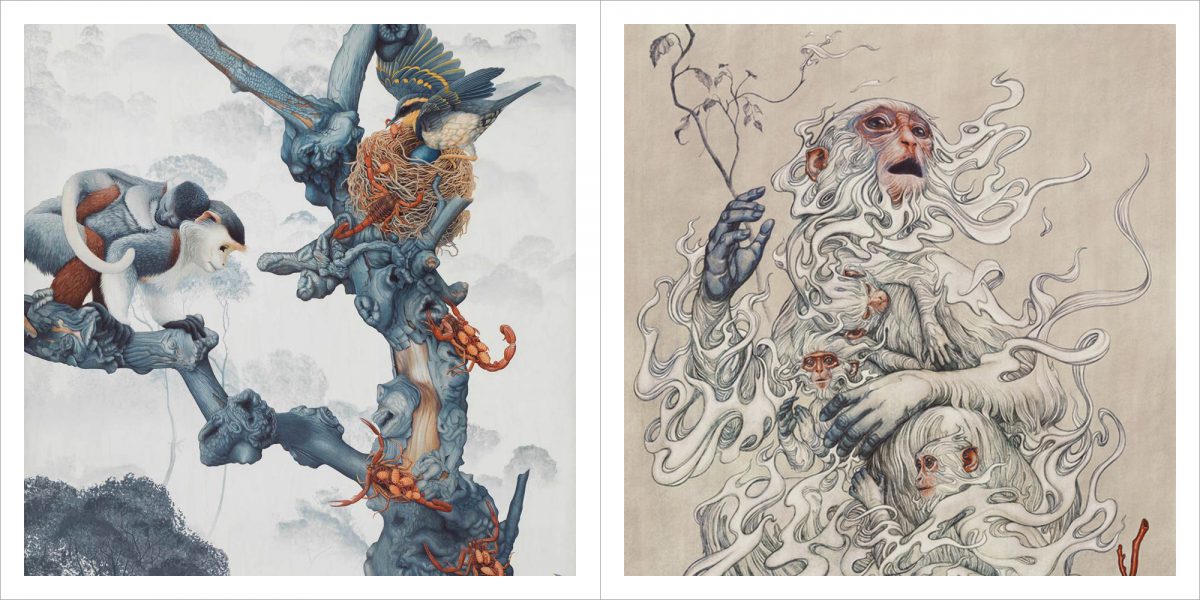THERE’S A TWITTER ACCOUNT called YearOnEarth that tweets our planet’s 4.54-billion-year history, compressed into the timescale of a single calendar year.
So January 1 is when a big ball of gas and dust starts forming in outer space, nudged on by a supernova. And it’s only the last few seconds of December 31 when people hit the scene and start stomping all over the place.
In between day 1 and day 365, oceans form, continents split, things bubble, wriggle, and bloom. Single-celled organisms debut in the spring. The ice age begins in late June. Dinosaurs start to roam by mid-December.
Then the day after Christmas, a big-ass* asteroid hits the planet. As YearOnEarth tweets, “the impact releases hundreds of billion times more energy than the atomic bombings of Hiroshima and Nagasaki.” And that’s it for the dinos.
(Though, they did survive for about half a month in the Twitter timeline, which is a pretty good run, relatively speaking. Also: they found dino feathers! I’ll never get over the fact that the “terrible lizards” of my childhood turned out to be more like terrifying birds.)
Along with snuffing out three-quarters of life on Earth, the extinction-level event also brought the end to the Cretaceous period and the Mesozoic era, leaving only the flying dino-birds and smaller critters behind to begin the Paleogene and the Cenozoic. This part of the planet’s history is written on the sides of cliffs for anyone to see: thin bands of rock marking the Cretaceous–Paleogene boundary, a sedimentary layer laden with iridium, likely left behind by the Earth’s big-ass visitor from outer space.
And you know what else is left behind when a big-ass, dinosaur-annihilating, era-ending space rock smashes into the world?
A big-ass crater.
According to its Wikipedia page, the crater is ninety-three miles wide and twelve miles deep, straddling the northwest coast of the Yucatán Peninsula, half on land, half under the sea, with the town of Chicxulub nearest its center.
It seems like a hard thing to miss. But as big as it is, the Chicxulub crater is also buried under sixty-six million years of stuff, so no one noticed it until the late 70s. Even after it was discovered, it took a long time (on a human timescale, not a geological one) before it was widely recognized as the dent in the universe that did in the dinos. Wikipedia:
The crater was discovered by Antonio Camargo and Glen Penfield, geophysicists who had been looking for petroleum in the Yucatán Peninsula during the late 1970s. Penfield was initially unable to obtain evidence that the geological feature was a crater and gave up his search. Later, through contact with Alan Hildebrand in 1990, Penfield obtained samples that suggested it was an impact feature. Evidence for the impact origin of the crater includes shocked quartz, a gravity anomaly, and tektites in surrounding areas.
Somehow I’m simultaneously amazed that the big-ass crater was identified so late in human history and that we have the ability to discover these things at all. (Also: shocked quartz? Gravity anomaly? Tektites? I don’t know what any of those things are, but I like the sound of all of them.)
Back in 1978, Penfield was just working his day job at the Mexican petroleum company Pemex when he noticed a pattern of geological anomalies and began to map them. In an article he wrote for the American Association of Petroleum Geologists just last December, he describes the moment when combining his hand-drawn map with old records revealed a complete outline of the crater:
Gravity mapping of the Yucatan began in the 1940s, which led to the drilling of the first exploration wells in the early 1950s. The old data showed a large concentric set of onshore gravity anomalies. When I laid it next to my No. 2 pencil mapping of the offshore magnetic anomalies, the fit was perfect: a shallow, 180-kilometer diameter gravity-magnetic bullseye on the almost non-magnetic, uniform carbonate background of the Yucatan platform!
(The exclamation point is what really sells it.)
At the time, Penfield was only twenty-six years old. But he’d seen enough geological surveys by then, so he was sure of what he was looking at:
I knew this was not a volcanic edifice, but an impact like those I had observed on the moon as a hobby since childhood. We recognized the crater as the likely Cretaceous–Paleogene boundary event.
But for the next twelve years, few others would. Penfield and Camargo presented a report at a geophysicists conference in 1981. Penfield says the Houston Chronicle put their session on the front of the Sunday paper. Still, no one took notice.
In the Wikipedia article, the conference is described as “under-attended” — possibly because all the crater and Cretaceous-Paleogene experts were at a different conference about planetary impacts, which was going on at the same time. The implication is that Penfield and Camargo just didn’t have the right audience: scientific breakthrough undermined by poor event scheduling.
Regardless, Glen Penfield’s crater theory was ridiculed by co-workers (they called it “Glen’s Sky Rock”), rejected by NASA, and dismissed by “a world-famous seismologist”. I wonder if Penfield spent the decade annoying family, friends, loose acquaintances, taxi drivers, and strangers in bars with his unheralded discovery: “You know, I think I found the spot where that asteroid that killed all the dinosaurs landed.”
Eventually, he gave up trying. Without more evidence (some of it was locked up by Penmex lawyers), nobody had reason to believe him. Or, the ones who did have a reason didn’t know Penfield existed, let alone his big-ass crater. It was like the nerdiest of romcoms — missed scientific connections. Wikipedia again:
At the same time, in 1980, geologist Walter Alvarez and his father, Nobel Prize-winning scientist Luis Walter Alvarez, put forth their hypothesis that a large extraterrestrial body had struck Earth at the time of the Cretaceous–Paleogene boundary. In 1981, unaware of Penfield’s discovery, University of Arizona graduate student Alan R. Hildebrand and faculty adviser William V. Boynton published a draft Earth-impact theory and sought a candidate crater.
Hildebrand was searching for the crater Penfield had already found. Nine years later, they finally found each other, via a matchmaker:
In 1990, Houston Chronicle reporter Carlos Byars told Hildebrand of Penfield’s earlier discovery of a possible impact crater. Hildebrand contacted Penfield in April 1990 and the pair soon secured two drill samples from the Pemex wells, stored in New Orleans. Hildebrand’s team tested the samples, which clearly showed shock-metamorphic materials.
Nothing says you’re meant for each other like your mutual appreciation for samples of shock-metamorphic materials.
No longer discounted as a seismic anomaly, the big-ass, ancient hole in the ground made by Glen’s Sky Rock officially became the Chicxulub crater. A seemingly innocuous name, it was born partly out of spite-fueled mischief, according to Penfield:
My Mayan wife, Erendira, and I, along with Alan, decided to name the crater after the town of Chicxulub located near its center, partly to give the academics and NASA naysayers a challenging time pronouncing it after a decade of their dismissals, since “Yucatan crater” was too easily pronounced.
Saucy scientists.
Since then, more evidence has been found to support the Chicxulub crater theories, even as recently as this last year:
In 2016, a scientific drilling project drilled deep into the peak ring of the impact crater, hundreds of meters below the current sea floor, to obtain rock core samples from the impact itself. The discoveries were widely seen as confirming current theories related to both the crater impact and its effects. A 2020 study concluded that the Chicxulub crater was formed by an inclined (45–60° to horizontal) impact from the northeast.
So that’s that: the impact of a big-ass space rock sixty-six million years ago still rippling into the present day. Twelve years from a young scientist’s initial discovery to his vindication, a period which probably felt more like an eternity. And 4.54 billion years compressed into one, 365-day trip around the sun.
In a year where time felt totally weird — simultaneously amorphous and acutely painful, both unlimited and interminable — this Twitter–Wikipedia rabbit hole, where timescales expand and contract with alarming elasticity, was another reminder that our time here is kind of a lark.
Time is a jumble. It’s both an essential concept for us all to agree on just so we can function in daily life — and also sorta just made-up. (Necessary and meaningless, kinda like money.) It bends and shrinks, slows down and speeds up, goes straight or in circles. The month of March can stretch on to feel like a year. And the end of an era can fit inside a tweet.
Zoomed out, our time on this little blue marble is less than a breath. As the YearOnEarth Twitter account ultimately concludes: humans are here for less than a blip, a few seconds (not even two minutes) before midnight — and yet (spoiler alert!) we’re as destructive as a big-ass asteroid that we can’t stop from crashing into a small town in the Gulf of Mexico.
Well, at least our time here isn’t boring, I guess. Happy new year.
*The asteroid is estimated to have been between seven to fifty miles in diameter. Which is a pretty wide spread, don’t you think, scientists? But even on the low end, a seven-mile-wide rock falling from the sky still counts as “big-ass” in my book.


